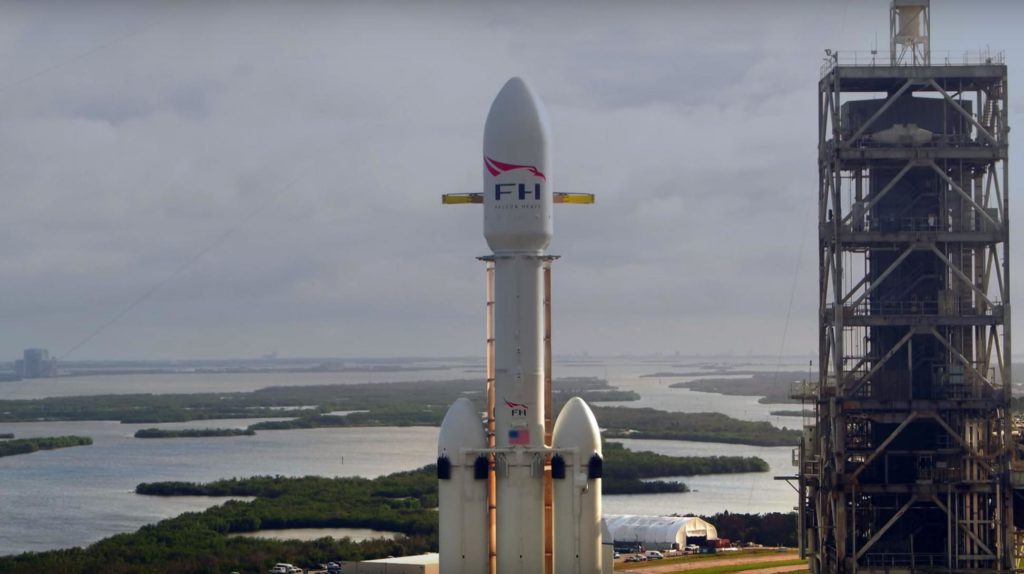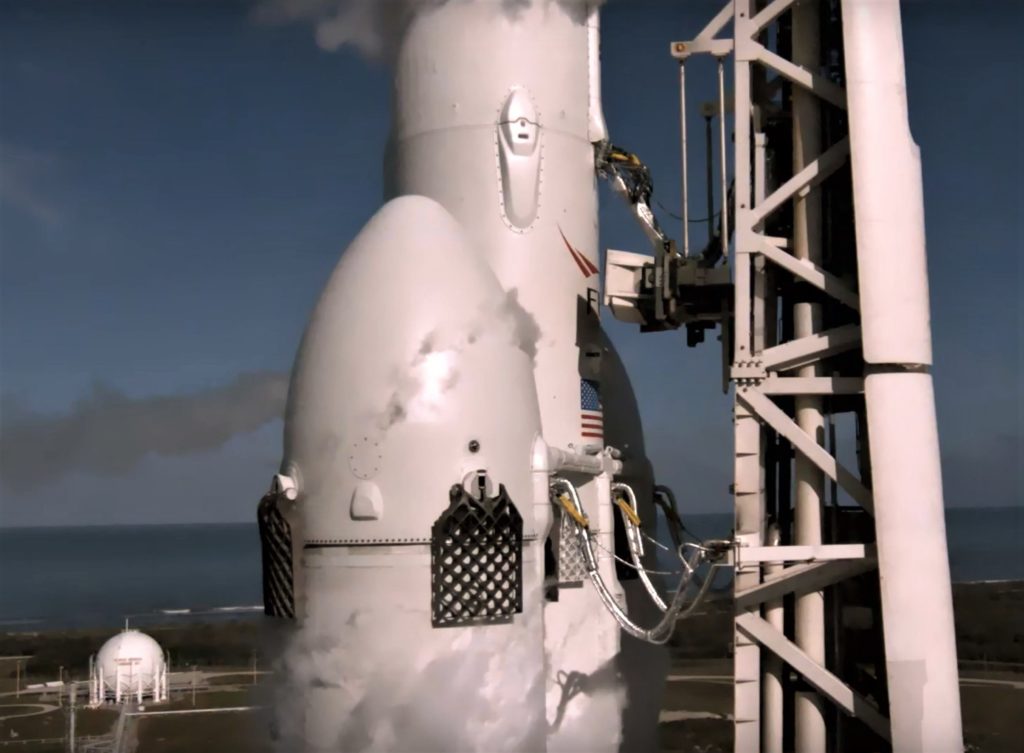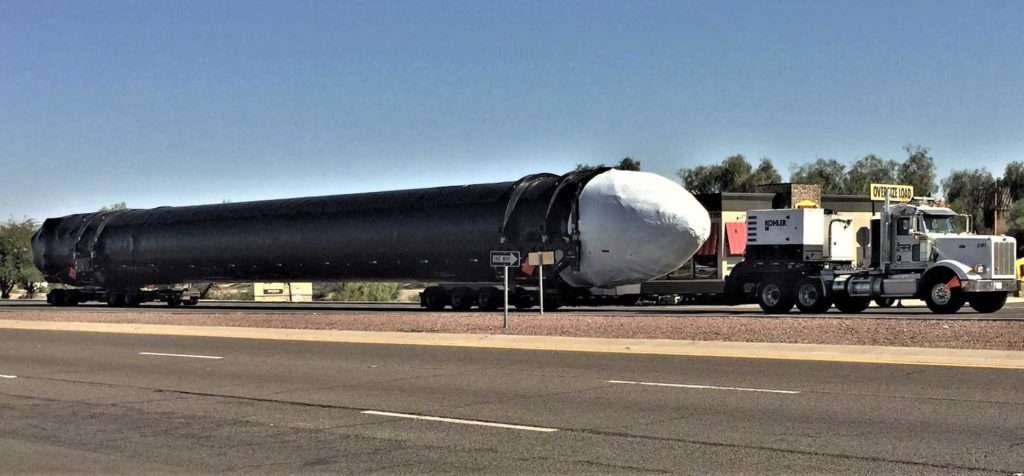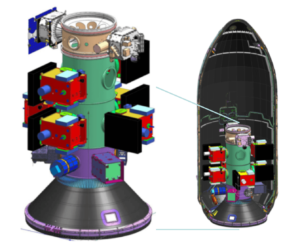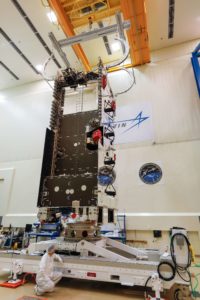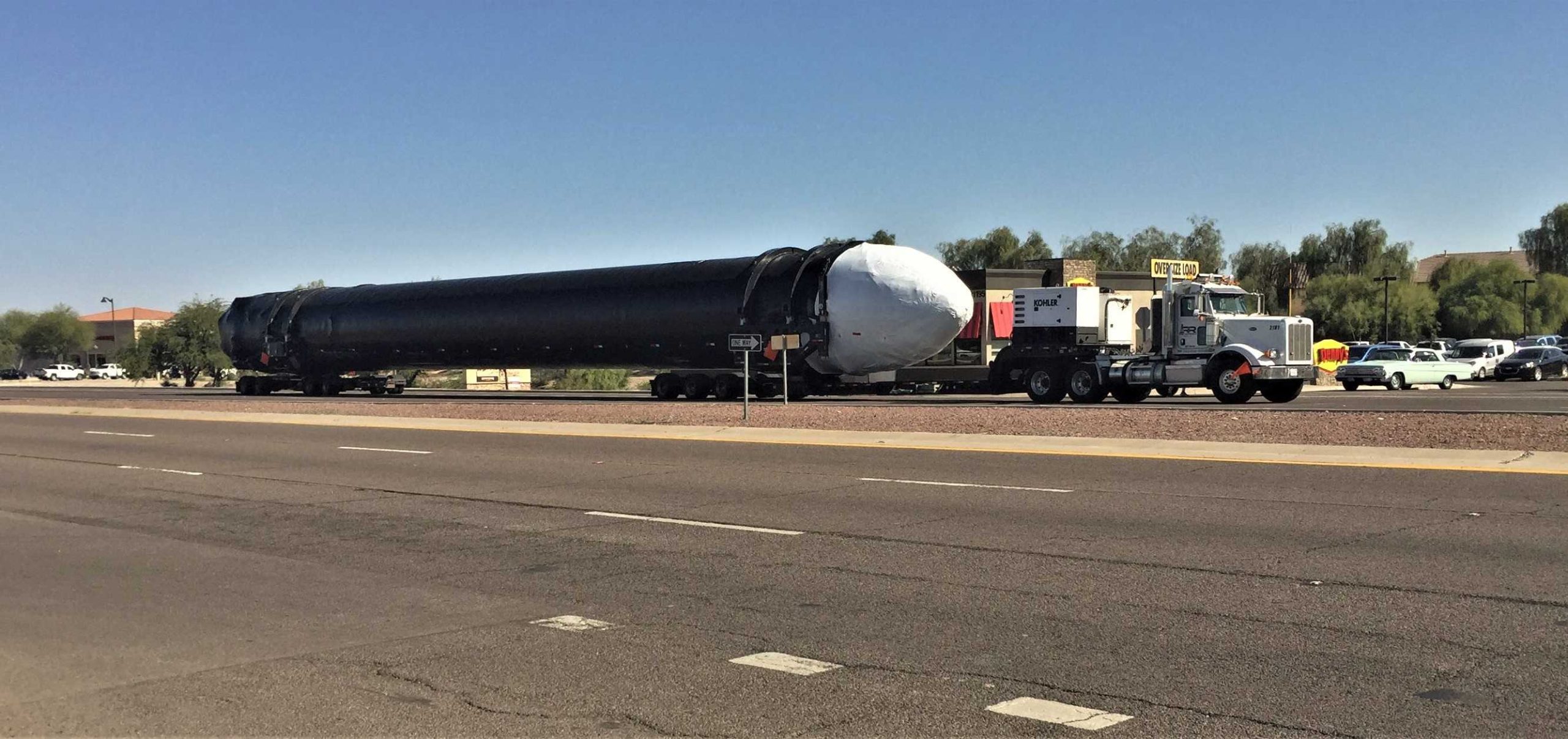
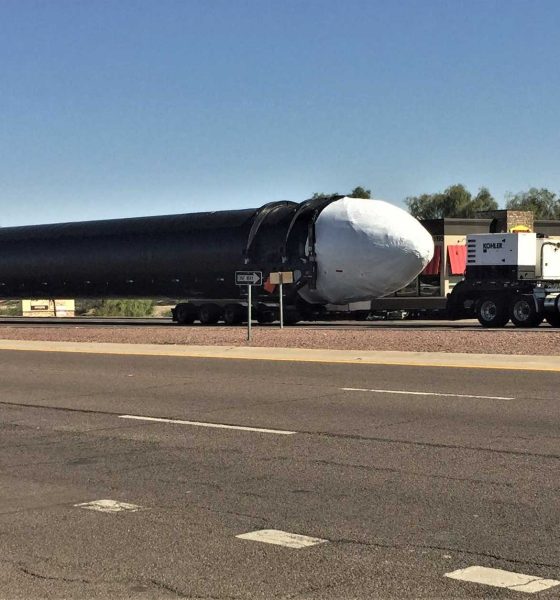
News
SpaceX’s next-gen Falcon Heavy closer to reality as side booster leaves factory
A duo of rocket spottings on November 9th and 10th confirm that SpaceX’s next Falcon Heavy rocket – an amalgamation of three Falcon 9 boosters, an upper stage, and extensive modifications – is already in the late stages of manufacturing and is nearing the beginning of integrated structural and static fire testing.
As of now, this Falcon Heavy side booster could end up supporting either or both of two near-term launch contracts in place for the rocket, communications satellite Arabsat 6A or the US Air Force’s second Space Test Program (STP-2) launch
SpaceX's second Falcon Heavy is slowly but surely coming together 😀 https://t.co/AYJsQ8Mld5
— Eric Ralph (@13ericralph31) November 13, 2018
The question of the hour – at least for Falcon Heavy – is which of those two available payloads will be atop the rocket on its first truly commercial launch. While suboptimal, a few general characteristics of each payload, SpaceX’s history of commercial launches, and Falcon Heavy itself can offer a hint or two.
Triple the rocket, triple the trouble
Thanks in large part to the fact that the first integrated Falcon Heavy was composed of two relatively old Falcon 9 booster variants and a center core that was quite literally a one-off rocket, the process of reenginering and building another Falcon Heavy rocket off of the family’s newest Block 5 variant has likely been far harder than simply building another Falcon Heavy. Although all three original Falcon Heavy boosters (B1023, B1025, and B1033) were in the same league as Block 5, their Block 2 and Block 3 hardware was designed for approximately 10% less thrust and are almost entirely different vehicles from the perspective of structures and avionics.
Perhaps even more importantly, it’s unknown whether Falcon Heavy Block 1 (for lack of a better descriptor) was designed with serious reusability in mind, at least in the same sense as Falcon 9 Block 5 was. For instance, a major portion of the rocket’s extreme complexity and difficulties lies in the basic need to transmit three times as much thrust through the center core. To do that and do it without rocket-powered separation mechanisms, SpaceX had to develop structural attachments and connections capable of surviving unbelievable mechanical and thermal stresses for minutes on end.
- The first Falcon Heavy was a Frankenstein’s monster of sorts. (SpaceX)
- Falcon Heavy is seen here lifting off during its spectacular launch debut. (SpaceX)
- A Falcon Heavy side booster was spotted eastbound in Arizona on November 10th. (Reddit – beast-sam)
Clearly, this was an unfathomably difficult problem to solve in such a manner that Falcon Heavy would work at all the first time. Factor in the strategic need for those same components to survive repeated cycles of those stresses with minimal refurbishment in between and the problem at hand likely becomes a magnitude more difficult, at least. In large part, this helps to explain why there will end up being a minimum of 11-12 months between Falcon Heavy’s first and second launches.
Arabsat or STP?
Over the course of SpaceX’s last 2-3 years of commercial launch activity, the company and its customers have demonstrated time and time again a reliable pattern: commercial customers (in the sense of private entities) are far more willing to take risks with new technologies than SpaceX’s government customers. NASA’s Commercial Resupply Services is the exception for the latter group but also has no Falcon Heavy launch contracts. For Falcon Heavy, there are thus main three options at hand.
- Arabsat 6A launches first with 1-2 flight-proven boosters; the Air Force’s STP-2 mission flies on an all-new Falcon Heavy 4-6 months later.
- SpaceX builds entirely new Falcon Heavy rockets for both customers, requiring four new side boosters and two new center cores.
- STP-2 launches first on an all-new Falcon Heavy; Arabsat 6A launches second on the first flight-proven Falcon Heavy after 6+ months of additional delays.
- The USAF’s STP-2, a combination of a few dozen different satellites. (USAF)
- The communications satellite Arabsat-6A. (Lockheed Martin)
- LZ-1 and LZ-2, circa February 2018. (SpaceX)
- A closeup of one of Falcon Heavy’s side boosters after landing. (SpaceX)
Arabsat is far more likely to accept – for a significant discount – a ride aboard the first flight-proven Falcon Heavy, especially if it means preventing more major launch delays. If the Falcon Heavy side booster spotted eastbound last week is a refurbished Block 5 booster rather than a new rocket, than option 1 is the easy choice for most probable outcome. The real pack leader for Falcon Heavy Flight 2, however, will be the completion of a new Block 5 center core and its shipment to Texas for structural and static fire testing.
Time will tell. For now, a completed Falcon Heavy side booster is the best sign yet that SpaceX may manage the rocket’s second launch in the first quarter of 2019, whichever launch that may be.

Elon Musk
Elon Musk and Tesla AI Director share insights after empty driver seat Robotaxi rides
The executives’ unoccupied tests hint at the rapid progress of Tesla’s unsupervised Robotaxi efforts.

Tesla CEO Elon Musk and AI Director Ashok Elluswamy celebrated Christmas Eve by sharing personal experiences with Robotaxi vehicles that had no safety monitor or occupant in the driver’s seat. Musk described the system’s “perfect driving” around Austin, while Elluswamy posted video from the back seat, calling it “an amazing experience.”
The executives’ unoccupied tests hint at the rapid progress of Tesla’s unsupervised Robotaxi efforts.
Elon and Ashok’s firsthand Robotaxi insights
Prior to Musk and the Tesla AI Director’s posts, sightings of unmanned Teslas navigating public roads were widely shared on social media. One such vehicle was spotted in Austin, Texas, which Elon Musk acknowleged by stating that “Testing is underway with no occupants in the car.”
Based on his Christmas Eve post, Musk seemed to have tested an unmanned Tesla himself. “A Tesla with no safety monitor in the car and me sitting in the passenger seat took me all around Austin on Sunday with perfect driving,” Musk wrote in his post.
Elluswamy responded with a 2-minute video showing himself in the rear of an unmanned Tesla. The video featured the vehicle’s empty front seats, as well as its smooth handling through real-world traffic. He captioned his video with the words, “It’s an amazing experience!”
Towards Unsupervised operations
During an xAI Hackathon earlier this month, Elon Musk mentioned that Tesla owed be removing Safety Monitors from its Robotaxis in Austin in just three weeks. “Unsupervised is pretty much solved at this point. So there will be Tesla Robotaxis operating in Austin with no one in them. Not even anyone in the passenger seat in about three weeks,” he said. Musk echoed similar estimates at the 2025 Annual Shareholder Meeting and the Q3 2025 earnings call.
Considering the insights that were posted Musk and Elluswamy, it does appear that Tesla is working hard towards operating its Robotaxis with no safety monitors. This is quite impressive considering that the service was launched just earlier this year.
Elon Musk
Starlink passes 9 million active customers just weeks after hitting 8 million
The milestone highlights the accelerating growth of Starlink, which has now been adding over 20,000 new users per day.

SpaceX’s Starlink satellite internet service has continued its rapid global expansion, surpassing 9 million active customers just weeks after crossing the 8 million mark.
The milestone highlights the accelerating growth of Starlink, which has now been adding over 20,000 new users per day.
9 million customers
In a post on X, SpaceX stated that Starlink now serves over 9 million active users across 155 countries, territories, and markets. The company reached 8 million customers in early November, meaning it added roughly 1 million subscribers in under seven weeks, or about 21,275 new users on average per day.
“Starlink is connecting more than 9M active customers with high-speed internet across 155 countries, territories, and many other markets,” Starlink wrote in a post on its official X account. SpaceX President Gwynne Shotwell also celebrated the milestone on X. “A huge thank you to all of our customers and congrats to the Starlink team for such an incredible product,” she wrote.
That growth rate reflects both rising demand for broadband in underserved regions and Starlink’s expanding satellite constellation, which now includes more than 9,000 low-Earth-orbit satellites designed to deliver high-speed, low-latency internet worldwide.
Starlink’s momentum
Starlink’s momentum has been building up. SpaceX reported 4.6 million Starlink customers in December 2024, followed by 7 million by August 2025, and 8 million customers in November. Independent data also suggests Starlink usage is rising sharply, with Cloudflare reporting that global web traffic from Starlink users more than doubled in 2025, as noted in an Insider report.
Starlink’s momentum is increasingly tied to SpaceX’s broader financial outlook. Elon Musk has said the satellite network is “by far” the company’s largest revenue driver, and reports suggest SpaceX may be positioning itself for an initial public offering as soon as next year, with valuations estimated as high as $1.5 trillion. Musk has also suggested in the past that Starlink could have its own IPO in the future.
News
NVIDIA Director of Robotics: Tesla FSD v14 is the first AI to pass the “Physical Turing Test”
After testing FSD v14, Fan stated that his experience with FSD felt magical at first, but it soon started to feel like a routine.

NVIDIA Director of Robotics Jim Fan has praised Tesla’s Full Self-Driving (Supervised) v14 as the first AI to pass what he described as a “Physical Turing Test.”
After testing FSD v14, Fan stated that his experience with FSD felt magical at first, but it soon started to feel like a routine. And just like smartphones today, removing it now would “actively hurt.”
Jim Fan’s hands-on FSD v14 impressions
Fan, a leading researcher in embodied AI who is currently solving Physical AI at NVIDIA and spearheading the company’s Project GR00T initiative, noted that he actually was late to the Tesla game. He was, however, one of the first to try out FSD v14.
“I was very late to own a Tesla but among the earliest to try out FSD v14. It’s perhaps the first time I experience an AI that passes the Physical Turing Test: after a long day at work, you press a button, lay back, and couldn’t tell if a neural net or a human drove you home,” Fan wrote in a post on X.
Fan added: “Despite knowing exactly how robot learning works, I still find it magical watching the steering wheel turn by itself. First it feels surreal, next it becomes routine. Then, like the smartphone, taking it away actively hurts. This is how humanity gets rewired and glued to god-like technologies.”
The Physical Turing Test
The original Turing Test was conceived by Alan Turing in 1950, and it was aimed at determining if a machine could exhibit behavior that is equivalent to or indistinguishable from a human. By focusing on text-based conversations, the original Turing Test set a high bar for natural language processing and machine learning.
This test has been passed by today’s large language models. However, the capability to converse in a humanlike manner is a completely different challenge from performing real-world problem-solving or physical interactions. Thus, Fan introduced the Physical Turing Test, which challenges AI systems to demonstrate intelligence through physical actions.
Based on Fan’s comments, Tesla has demonstrated these intelligent physical actions with FSD v14. Elon Musk agreed with the NVIDIA executive, stating in a post on X that with FSD v14, “you can sense the sentience maturing.” Musk also praised Tesla AI, calling it the best “real-world AI” today.
